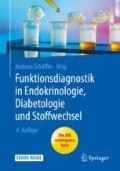Zusammenfassung
Erläutert werden alle relevanten Funktionstests mit ausführlicher Darstellung von Indikationen, Kontraindikationen, Nebenwirkungen, Testvorbereitung, Rahmenbedingungen, konkreten Handlungsanleitung der eigentlichen Testdurchführung sowie der Interpretation der Testergebnisse. Es werden immer konkrete Normbereiche und Cut-off-Werte angegeben, auch für besondere Situationen (Geschlecht, Alter, BMI, Pubertätsphasen, Zyklusphasen, akute Erkrankungen, Medikamente etc.). Ein besonderes Merkmal ist die Betonung der Testvorbereitung, -durchführung und -interpretation sowie des interdisziplinären Charakters. Ziel dieses Kapitel ist eine orientierende, praxisrelevante Darstellung der wichtigsten lipidologischen Parameter sowie der Methodik zur Risikostratifizierung.
Access this chapter
Tax calculation will be finalised at checkout
Purchases are for personal use only
Literatur
Schwandt P, Richter WO, Parhofer KG (2000) Handbuch der Fettstoffwechselstörungen. Schattauer, Stuttgart
Lipid-Liga. Diagnostik und Therapie von Fettstoffwechselstörungen in der ärztlichen Praxis. Deutsche Gesellschaft zur Bekämpfung von Fettstoffwechselstörungen und ihren Folgeerkrankungen DGFF (Lipid-Liga) e.V. www.lipid-liga.de/fuer-aertze/empfehlungen. Zugegriffen am 01.02.2018
De Backer GE, Ambrosioni K, Borch-Johnsen C, Brotons R, Cifkova J, Dallongeville S, Ebrahim O, Faergeman I, Graham G, Mancia V, Manger Cats K, Orth-Gomer J, Perk K, Pyorala JL, Rodicio S, Sans V, Sansoy U, Sechtem S, Silber T, Thomsen T, Wood D (2003) European guidelines on cardiovascular disease prevention in clinical practice. Third joint task force of European and other societies on Cardiovascular Disease Prevention in Clinical Practice. Eur Heart J 24:1601–1610
Assmann G, Cullen P, Schulte H (2002) Simple scoring scheme for calculating the risk of acute coronary events based on the 10-year follow-up of the prospective cardiovascular Munster (PROCAM) study. Circulation 105:310–315
Grundy SM, Cleeman JI, Merz CN, Brewer HB Jr, Clark LT, Hunninghake DB, Pasternak RC, Smith SC Jr, Stone NJ (2004) Implications of recent clinical trials for the National Cholesterol Education Program Adult Treatment Panel III guidelines. Circulation 110:227–239
The National Cholesterol Education Program (NCEP). Expert Panel on Detection and Treatment of High Blood Cholesterol In Adults (Adult Treatment Panel III) (2001) Executive summary of the third report of the National Cholesterol Education Program (NCEP). Expert panel on detection, evaluation, and treatment of high blood cholesterol in adults (Adult treatment panel III). JAMA 285:2486–2497
Berg K (1963) A new serum type system in man – the Lp system. Acta Pathol Microbiol Scand 59:369–382
Deutsche Vereinte Gesellschaft für Klinische Chemie und Laboratoriumsmedizin (D. V. G. f. K.). LabTestsOnlineDE: Harnstoff. Harnsäure.Lipide. Lp(a). In: Informationsportal zur medizinischen Labordiagnostik, produziert durch die Deutsche Vereinte Gesellschaft für Klinische Chemie und Laboratoriumsmedizin, den Verband der Diagnostica-Industrie e.V. und die European Diagnostic Manufacturers Association, in Assoziation mit der American Association of Clinical Chemistry. www.labtestsonline.org. Zugegriffen am 01.02.2018
Friedewald WT, Levy RI, Fredrickson DS (1972) Estimation of the concentration of low-density lipoprotein cholesterol in plasma, without use of the preparative ultracentrifuge. Clin Chem 18:499–502
Grammer T, Scharnagl H, März W (2016) Rationelle Lipiddiagnostik. Klinikarzt 45:74–81
Kassner U, Dippel M, Steinhagen-Thiessen E (2017) Internist 58:866–876
Reiner Z, Catapano AL, De Backer G et al (2011) Guidelines for the management of dyslipidaemias: the task force for the management of dyslipidaemias of the European Society of Cardiology (ESC) and the European Atherosclerosis Society (EAS). Atherosclerosis 32:1769–1818
Richter WO (2005) Taschenbuch der Fettstoffwechselstörungen. Praktische Diagnostik und Therapie, 2. Aufl. Wissenschaftliche Verlagsgesellschaft mbH, Stuttgart
Author information
Authors and Affiliations
Corresponding author
Editor information
Editors and Affiliations
Rights and permissions
Copyright information
© 2018 Springer-Verlag GmbH Deutschland
About this chapter
Cite this chapter
Schäffler, A. et al. (2018). Lipidstoffwechsel. In: Schäffler, A. (eds) Funktionsdiagnostik in Endokrinologie, Diabetologie und Stoffwechsel. Springer, Berlin, Heidelberg. https://doi.org/10.1007/978-3-662-55914-7_3
Download citation
DOI: https://doi.org/10.1007/978-3-662-55914-7_3
Published:
Publisher Name: Springer, Berlin, Heidelberg
Print ISBN: 978-3-662-55913-0
Online ISBN: 978-3-662-55914-7
eBook Packages: Medicine (German Language)

